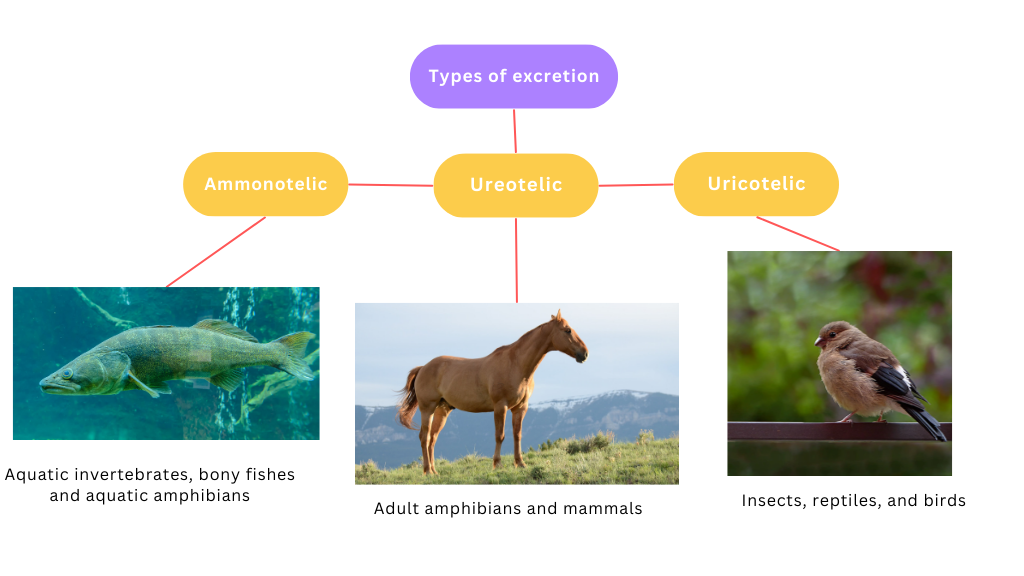Introduction
All species, whether they have one cell or many, engage in diverse metabolic processes. The body produces harmful chemicals as a result of these processes. To prevent excessive accumulation of these waste products in the body, they must be excreted. The excretory system of the body performs the function of eliminating waste. Different species emit different wastes, and they are divided into 3 types- , Uricotelic, and Ammonotelic. The poisonous waste products produced by bodily metabolism must be eliminated from the body and this is done through the process of excretion.
 Excretion
Excretion
Excretion is the process through which nitrogenous waste is expelled from the body. The excretory system in humans and the majority of chordates is responsible for the process of excretion. The human excretory system consists of two kidneys that filter the blood and remove the primary nitrogenous waste- Urea from the body. Nephrons, the kidney’s functional unit, filter blood and remove urea by the process of urine formation. Excretion is a very important step and it helps in maintaining the homeostasis of the body. Various organisms which stay in the abundance of water have their excretory products in the form of Ammonia and such are called ammonotelic organisms.
Ammonotelism
- Ammonia is a waste product that some species, including amoeba, protozoa, echinoderms, Platyhelminthes, poriferans, cnidarians, and aquatic mammals, produce.
- These organisms are known as ammonotelic organisms and the process of excretion by such organisms is known as .
- To expel waste from their bodies, these organisms perform diffusion. The waste is excreted through their skin, gills, or kidneys.
- Ammonia has a small molecular size and it easily dissolves in water hence excretion is simple in aquatic animals.
- Elimination of ammonia from the body is very essential because when ammonia dissolves in water it generates ammonium hydroxide, which can result in necrosis of the tissues.
- Ammonotelism is the least energy-consuming and most water-intensive method of excretion. This is so because 1 gram of ammonia requires approx 500ml of water.
Physiological Aspect of Ammonotelic Excretion
- Fish and other aquatic species eat food that is high in protein and other nutrients.
- These organisms are unable to store amino acids for a long period, hence their intestines are designed for the deamination of amino acids.
- Uric acid is created during the process of deamination.
- Uric acid is oxidized which leads to the formation of Allantoin and allantoic acid.
- Allantoin is hydrolyzed to form allantoate, and subsequent hydrolysis produces urea and glyoxylate.
- Urea is further broken down into ammonia and carbon dioxide in ammonotelic species.
- This ammonia then dissolves with the water and is expelled out of the body.
Osmoregulation
Osmoregulation is the process of controlling the osmotic pressure of bodily fluids to maintain the water balance of the body. Since the cells of marine creatures are isotonic with saltwater, no regulatory mechanism is necessary. However, to keep the electrolyte balance in the body other organisms’ osmoregulation is a must. Osmoregulation helps maintain salts and water balance in the body. For instance, the antidiuretic hormone (ADH, also known as vasopressin) regulates the content of urine in humans. when the body’s water content is low More water is reabsorbed due to the presence of ADH. This leads to less urine production. More urine is produced when the body’s water content is high. Excretion and osmoregulation work in unison to make sure the steady state of the body is maintained.
Importance of Excretion
Excretion is a very important physiological process of the body. Its significance is given below.
- Excretion helps in the regulation of blood ionic composition.
- It helps in controlling blood pH.
- Regulation of blood volume and blood pressure is done through this process.
- It helps in maintaining blood osmolarity.
- The excretion of waste and foreign substances helps in cleaning the body of toxic and harmful wastes.
- It assists in the maintenance of osmoregulation in the body.
Summary
Animals’ diets provide them with more amino acids. Ammonia, urea, and uric acid are excretory products that are created during the metabolism of proteins, amino acids, or nucleic acids. Organisms that are ammonotelic release ammonia as a waste product through their gills, skin, and kidneys. Removal of ammonia requires less energy. The regulation of water ion balance and homeostasis depends on the excretion of waste. By controlling the electrolyte balance, every organism keeps its internal environment in a steady state.
Frequently Asked Questions
1. Enlist excretory organs from different organisms.
Ans: Other excretory organs seen in various organisms are-
- Planaria – Flame cells
- Earthworm- Nephridia
- Cockroaches- malpighian tubules
- Prawns- green glands
- Molluscs- Renal glands
2. What are ureotelic and uricotellic organisms?
Ans: Ureotelic organisms – They release Urea as a waste product which is less toxic examples-Mammals and amphibians.
Uricotelic organism- They release Uric acid as a waste product which is the least toxic. examples- Birds, reptiles, and insects.
3. Only aquatic animals are ammonotelic. Give reasons why?
Ans: Ammonia is highly toxic and hence cannot be stored in an organism’s body. Expulsion of ammonia from the body requires lots of water and hence aquatic animals such as fish only have the ability to form waste products in the form of ammonia.